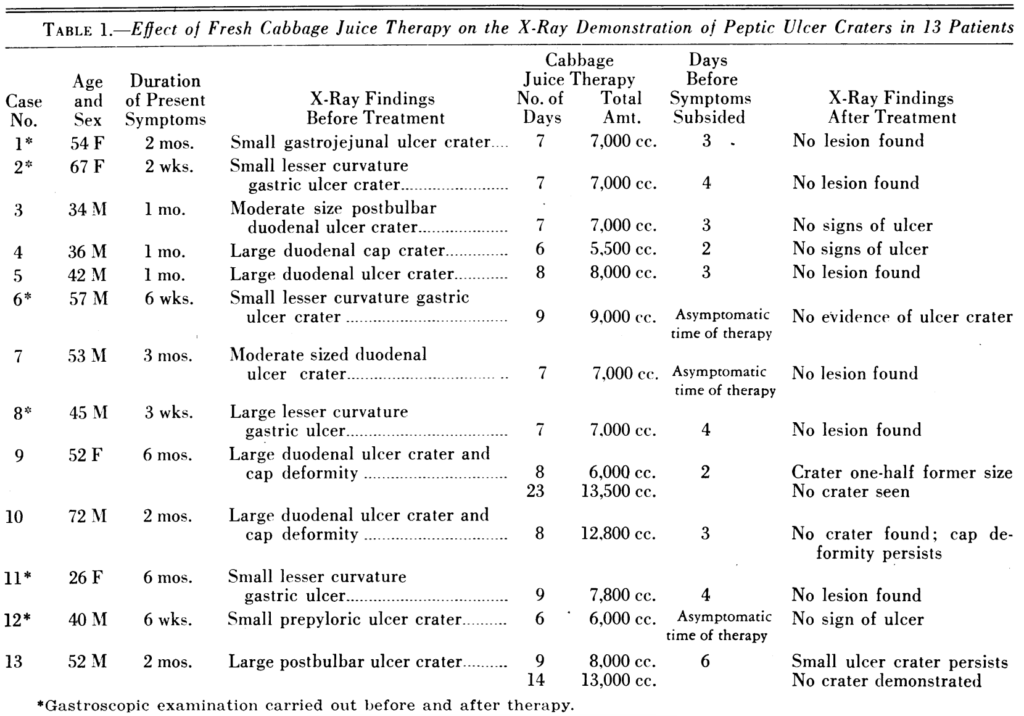In 1949, a fascinating study was published in the first issue of the 70th volume of California Medicine, the journal of the California Medical Association. The study, titled “Rapid Healing of Peptic Ulcers in Patients Receiving Fresh Cabbage Juice” showed the remarkable healing power of raw cabbage juice.
Here is the abstract of the study:
“Thirteen patients with peptic ulcer were treated with fresh cabbage juice, which, experiments have indicated, contains an anti-peptic ulcer factor. This factor (vitamin U) prevents the development of histamin-induced peptic ulcers in guinea pigs.
The average crater healing time for seven of these patients who had duodenal ulcer was only 10.4 days, while the average time as reported in the literature, in 62 patients treated by standard therapy, was 37 days.
The average crater healing time for six patients with gastric ulcer treated with cabbage juice was only 7.3 days, compared with 42 days, as reported in the literature, for six patients treated by standard therapy.
The rapid healing of peptic ulcers observed radiologically and gastroscopically in 13 patients treated with fresh cabbage juice indicates that the anti-peptic ulcer dietary factor may play an important role in the genesis of peptic ulcer in man.”
As part of the study, the patients were allowed to consume milk, eggs, some animal flesh (excluding pork, ham, bacon, and fatty meats), and cooked vegetables, including peas, green beans, asparagus, tomatoes (which is technically a fruit), carrots, beets, baby lima beans, artichoke hearts, and squash.
In addition, they the patients could have cooked potatoes (fried potatoes were not allowed), rice, pasta, dark bread and cereals, and moderate amounts of butter and lard.
Other foods that were permitted included cooked or canned fruits (peaches, pears, apples, cherries, apricots, strained orange juice or tomato juice), jello, puddings, fruit pies, and cake. Ice cream was not allowed.
For beverages, the patients could consume fruit juices, powdered roasted grain beverage (a coffee substitute), as well as some coffee and tea.
Sugar, honey, and jelly were also allowed. However, the patients were forbidden from consuming nuts and seeds.
If you think that this diet does not seem conducive to healing, you are absolutely correct. After-all, how can removing almost all fresh, raw (living), enzyme-rich fruits and vegetables help in repairing and regenerating damaged tissues?
This specific diet was chosen for a reason, however.
That reason behind excluding uncooked foods was to eliminate possible sources of the anti-peptic ulcer factor—found in fresh cabbage—which is readily destroyed by heating.
That said, the study participants were required to consume at least 1 liter (approximately 34 fl. oz.) of fresh, green cabbage juice daily, which had to be made using a hydraulic press extractor. (I always recommend that people invest in a masticating juicer that uses an auger, or augers, to slowly squeeze the juice out of produce without heating it [unlike high-speed/centrifugal juicers]. Slow juicers produce juice of superior quality; juice that contains appreciably more nutritious that the juice produced with a regular high-speed juicer. Moreover, slow juicers yield significantly more juice than centrifugal juicers, especially when processing fibrous plants like leafy greens and herbs.)
It took, on average, approximately 4.5 pounds of cabbage to make 1 liter of cabbage juice.
Some patients began with half that amount (17–20 fl. oz.) for a few days until they became accustomed to the acquired taste of raw cabbage juice and started to consume the full amount.
The cabbage juice was prepared fresh twice per day, and was divided into 5 daily doses of just under 7 ounces (almost one cup) each. The juice was served to the patients in the morning, at lunch, in mid-afternoon, at supper, and in the early evening.
There were a few patients who found the raw cabbage juice more palatable when combined with raw celery juice. These patients thus received a blend consisting of 75% cabbage juice and 25% celery juice.
The results of this study were impressive:
“In 11 of the 13 cases the craters disappeared within six to nine days…In one patient in our series, case 13, the crater took 14 days to ‘heal’…and in one, case 9, 23 days…The average healing time for the total of 13 cases of peptic ulcer treated with cabbage juice was nine days.”
It continues:
“The results of gastroscopic examination proved even more dramatic in the six cases of gastric ulcers than the x-ray demonstration of rapid crater healing. In two of these patients, case 1 with three small gastrojejunal ulcers visualized through the gastroscope and case 11 in which two small gastric ulcers were seen on the lesser curvature of the stomach, the lesions appeared to be completely healed at the time of the second gastroscopic examination which followed treatment. In the other four cases typical healing lesions could still be identified after treatment but crater depression was either not discernible or so slight as to be almost indistinguishable.”

The author also aptly acknowledges the importance of raw foods in the prevention and healing of peptic ulcers:
“The fact that the anti-peptic ulcer factor is readily destroyed by heat indicates that the preparation of food for human consumption by heating or cooking may completely destroy this factor. If this is so, it may become necessary to include certain raw foods in the diet of peptic ulcer patients, not only to promote the healing of ulcers which have already formed, but to prevent the development of lesions in the future.”
If you or someone you know experiences peptic ulcers, incorporating raw cabbage juice into the diet may be a wise thing to do. I would, however, only use organically grown cabbage without harmful agricultural products and make sure to consume plenty of unheated vegetables and non-acidic or low-acid fruits.
Moreover, I would eschew ultra-processed foods, grains, refined sugar, and animal products altogether, as they tend to induce the production of excessive acid in the body, which is counterproductive healing.
